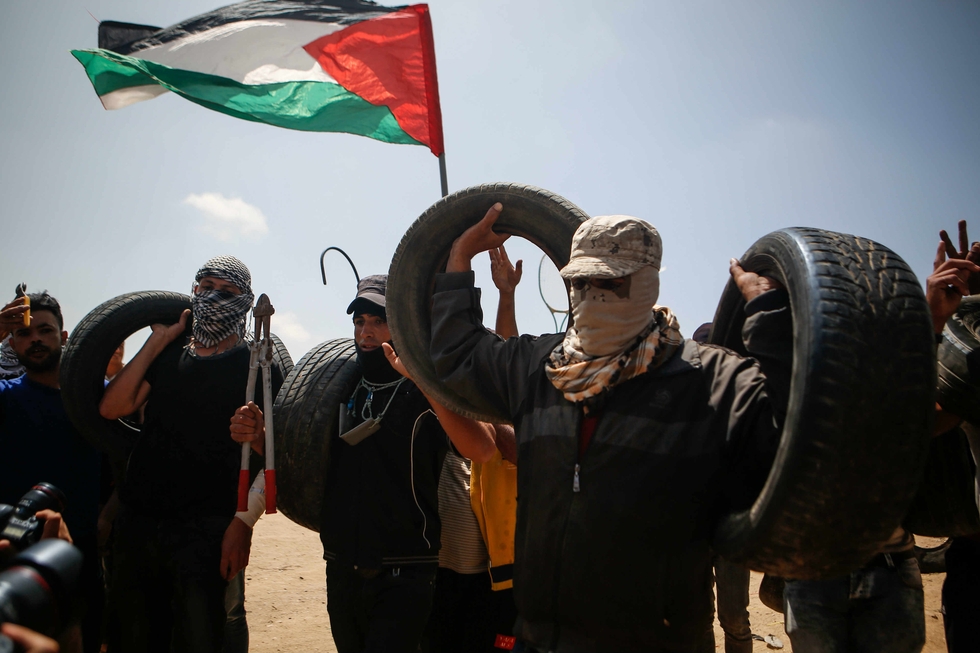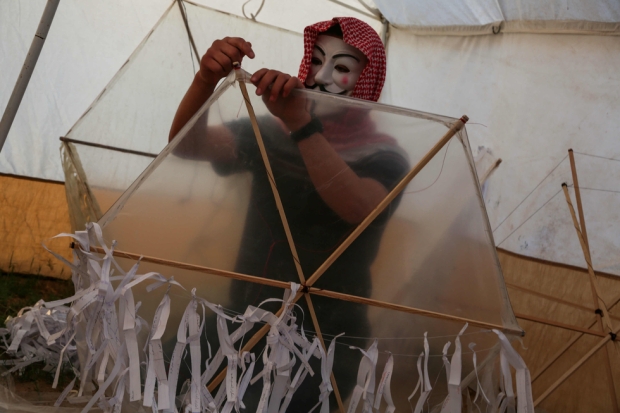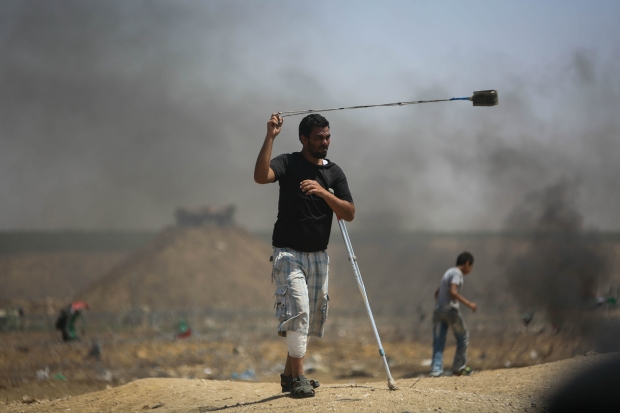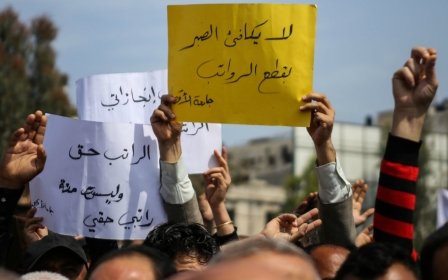One Palestinian killed in last Gaza protest before Nakba Day

GAZA CITY - One Palestinian was killed in Gaza on Friday as the six-week “Great March of Return” headed into its last days ahead of Nakba Day on 15 May.
Palestinians in the Gaza Strip are joining demonstrations to demand the right of return sought by the besieged territory’s 1.3 million refugees.
The Gaza Ministry of Health identified the slain Palestinian as Jaber Salem Abu Mustafa, 40, adding that he was shot in the chest by Israeli forces east of Khan Younis.
Demonstrators have been gathering several hundred metres from the fence separating Israel from Gaza since 30 March to demand the right to return to their pre-1948 homes, highlighting different issues at stake in the blockaded strip - such as unemployment and the struggles of Palestinian youth.
Reports emerged on Friday that Israeli forces were heavily firing tear gas at the crowds in some areas, while at least five protesters were shot with live bullets east of Gaza City.
Another person was also reportedly shot east of Khan Younis, in the southern Gaza Strip, where a crew of journalists from Al-Aqsa TV was allegedly targeted with tear gas.
Several journalists were reported injured by live bullets and tear gas canisters across the Gaza Strip.
The ministry of health reported that 448 people had been injured as of 5pm local time, including at least 25 minors and one paramedic.
The ministry shared a graphic photograph of a 16-year-old boy in critical condition after having his cheek perforated by unidentified ammunition east of al-Bureij refugee camp in the central Gaza Strip.
Earlier in the day protesters partially removed barbed wire set up by Israeli forces near the fence to prevent Palestinians from getting closer.
Friday's demonstration was dubbed "Preparedness and Foreboding Friday", in anticipation of the final protest of the march early next week.
The march was initially set to end on 15 May - the 70th anniversary of the Palestinian Nakba (Catastrophe), in which more than 750,000 Palestinians were forcibly displaced by Israeli forces during the 1948 Arab-Israeli war.
However, the final demonstration has been scheduled for Monday 14 May due to the imminent beginning of the Muslim holy month of Ramadan.
“On 14 and 15 May, we will fly kites with peaceful slogans for our right of return, we will burn tyres and cut the barbed wire, as we do not recognise this fence nor the Israeli borders,” Ayman, a member of the group of protesters who lead the activities closer to the fence, told MEE while holding large pliers meant to cut through the barbed wire.
Monday also marks the day when the United States is set to relocate its embassy in Israel from Tel Aviv to Jerusalem, a move that has provoked anger among Palestinians.
As the protests approach their climax, Hamas’s leader in Gaza, Yahya Sinwar, said the group - one of several Palestinian political parties in Gaza that have come out in support of the Great March of Return - would not stop protesters from breaching the Israeli security fence along Gaza’s perimeter.
“What's the problem with hundreds of thousands breaking through a fence that is not a border?" he said on Thursday, speaking to foreign journalists for the first time since taking his role in 2017.
'The scent of my village'
A number of older refugees participated in Friday’s protest, reminiscing about their childhood memories before and during the Nakba of 1948.
“Today is the first time in my life I have come near the border. I stand near the return protest tents, and I turn my sight northeast in the direction of Bir Saba,” 73-year-old refugee Umm Usama told Middle East Eye on Friday, referring to her village of origin, now the location of the Israeli city of Beersheba.
“I keep in my heart all the stories that my father used to tell me about my village. I can still smell the scent of my village.
“I am relieved to see how this generation is aware of their right of return, unafraid of Israeli artillery,” she added. “The Israelis should not kill our right of return the same way they kill our children.”
“But our rights make us stronger. I will be the first to participate in the Nakba Day protest, I will come with my relatives and neighbours so that the whole world witnesses our unified stance for our right of return.”
According to the latest Gaza ministry of health tally on Wednesday, Israeli forces stationed behind the fence had killed 47 Palestinians and wounded 8,536 during demonstrations. AFP has counted an additional five Palestinian deaths since 30 March, outside the scope of the protests.
Wael, 29, was shot in the leg during a demonstration on 4 May, but nonetheless returned to protest a week later, despite still being on crutches.
“I am unemployed, I have no hope in this life. I protest hoping that we can change our lives, advocate for our rights and lift the siege imposed against Gaza. We want to let the whole world know that the humanitarian crisis in Gaza needs to end,” he told MEE. “Our right of return is our last hope.”
No Israeli casualties have been reported, although several fires have erupted along the border after kites carrying improvised incendiary devices made their way into Israel.
On Friday, Israeli police reported on social media that three Israelis had been arrested after trying to fly kites into Gaza to set lands there on fire.
The Israeli army’s violent response to the demonstrations has sparked outrage globally, as more than 2,000 Palestinians have been struck by live bullets, and 24 wounded had to undergo amputations after being denied Israeli permits to exit Gaza and receive treatment in the occupied West Bank.
International NGO Save the Children denounced on Friday the army's targeting of Palestinian minors in Gaza, noting that out of more than 700 wounded children, at least 250 had been hit by live bullets.
"We are deeply concerned by the high number of children who have been hit by live ammunition and we agree with the high commissioner for human rights that this could suggest an excessive use of force and may amount to unlawful killing and maiming,” Jennifer Moorehead, Save the Children’s country director for the occupied Palestinian territory, said in a statement.
“The result has been devastating for the children of Gaza - physically and psychologically. Many have been injured, and many more have seen their parents or loved ones either hurt at the protests, or suffering increasing hardship in their daily lives."
The Israeli army has rejected repeated pleas by the international community - including the United Nations - to use restraint and to conduct an independent inquiry into the deaths, maintaining the necessity of its open-fire policy, which it says targets "terrorists".
Meanwhile, Amnesty International has called for a global arms embargo against Israel, accusing its forces of "carrying out a murderous assault" against Palestinians in the Gaza Strip.
Reporting in Gaza by Amjad Ayman.
New MEE newsletter: Jerusalem Dispatch
Sign up to get the latest insights and analysis on Israel-Palestine, alongside Turkey Unpacked and other MEE newsletters
Middle East Eye delivers independent and unrivalled coverage and analysis of the Middle East, North Africa and beyond. To learn more about republishing this content and the associated fees, please fill out this form. More about MEE can be found here.







